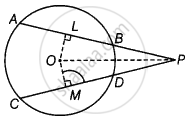Advertisements
Advertisements
Question
Two equal chords AB and CD of a circle when produced intersect at a point P. Prove that PB = PD.
Solution
Given: Two equal chords AB and CD of a circle intersecting at a point P.
To prove: PB = PD
Construction: Join OP, draw OL ⊥ AB and OM ⊥ CD

Proof: We have, AB = CD
⇒ OL = OM ...[Equal chords are equidistant from the centre]
In ΔOLP and ΔOMP,
OL = OM ...[Proved above]
∠OLP = ∠OMP ...[Each 90°]
And OP = OP ...[Common side]
∴ ΔOLP ≅ ΔOMP ...[By RHS congruence rule]
⇒ LP = MP [By CPCT] ...(i)
Now, AB = CD
⇒ `1/2 (AB) = 1/2 (CD)` ...[Dividing both sides by 2]
⇒ BL = DM ...(ii) [Perpendicular drawn from centre to the circle bisects the chord i.e., AL = LB and CM = MD]
On subtracting equation (ii) and equation (i), we get
LP – BL = MP – DM
⇒ PB = PD
Hence proved.
APPEARS IN
RELATED QUESTIONS
If two equal chords of a circle intersect within the circle, prove that the segments of one chord are equal to corresponding segments of the other chord.
If a line intersects two concentric circles (circles with the same centre) with centre O at A, B, C, and D, prove that AB = CD (see given figure).

true or false
If a circle is divided into three equal arcs each is a major arc.
true or false
A circle has only finite number of equal chords.
Find the length of a chord which is at a distance of 4 cm from the centre of the circle of radius 6 cm.
In a circle with centre O, AB and CD are two diameters perpendicular to each other. The length of chord AC is
Two equal circles of radius r intersect such that each passes through the centre of the other. The length of the common chord of the circle is
Two chords AB and CD of a circle are each at distances 4 cm from the centre. Then AB = CD.
Two chords AB and AC of a circle with centre O are on the opposite sides of OA. Then ∠OAB = ∠OAC .
Two congruent circles with centres O and O′ intersect at two points A and B. Then ∠AOB = ∠AO′B.
